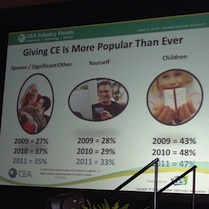HOUR 3:
Tech News & Commentary
Norman in Chatanooga, Tennessee asked: “I’ve been looking at all these tablets and have seen some cheap ones. I love the Android OS for my phone, so I was wondering if you have a recommendation for a good tablet that’s cheap.”
There are plenty of Android Tablets to choose right now in the market. The Viewsonic G Tablet for example is a fan favorite. It’s relative inexpensive and easily modded. Inside is a 1GB dual-core Tegra 2 chipset, 512 Mb of DDR2 Ram and enough video juice to run 1080p video and run Android 2.2. The Viewsonic is available online for $269.
Another Tablet you can try is the Anchos 101, this tablet run Android 2.2 and comes in both 8Gb or 16Gb.
Both has the same 10.1 inch screen, Cortex-A8 CPU and long life lithium iom battery. Ports are plentiful with a full size of USB 2.0 port, USB 2.0 slave port, MicroSD card slot and HDMI output, plus there is a nifty kickstand.
The Anchos 101 is available online for $240.
You can try the Nook Color, this tablet is a e-book reader with vibrant 7inch touch screen.
Build in WiFi, Barnes & Noble NookBook store, 8Gb Memory, micro SD expansion slot.
Support PDF,Word and Pub files, display images, some video formats and mp3 audio playback.
You can buy the Nook Color online for $225.
For more information, tune in to Hour 3 of our podcast.
“Into Gaming Update” Weekly Feature with Mark Lautenschlager
Jack in Los Alamos, New Mexico listening on KTRC asked: “I am really sick of the extortion of my satellite provider and wondering what is needed to start watching television programs over the Internet. In particular, I need a cookbook. What hardware and software do I need. I have a DSL connection which is okay, not fantastic. I’m at least willing to try it.”
You’re not alone. A lot of people are sick and tired of being at the mercy of their satellite or cable company. Of course, a lot more people are perfectly happy with whichever one they’ve chosen. So, we can’t paint with too broad of a brush here, despite the unfortunate circumstances several on our staff have had with CONcast (as Dave calls Comcast). I think what frustrates most people is the feeling of having no choice. You use the cable provider that’s in your area, or you use one of the two big brands in satellite TV, and that’s pretty much it. No consumer appreciates a lack of choice, nor should they.
The problem with providing you a “cookbook” of how to watch TV over the Internet is that the recipes are going out of date faster than they can be cooked. Food isn’t the best analogy, because good food is good food, and nobody has come up with a new version of green peppers that requires an upgrade to your onion and won’t work at all with the chicken broth. The services offering online TV watching are shifting constantly.
Before we discuss anything else, let’s talk about your Internet connection. DSL, at least the standard 1.5 megabit downstream and 256 kilobit upstream version, isn’t going to cut it. A switch to cable Internet, Verizon FIOS, or AT&T U-verse is in your future, I’m afraid. To watch movies and TV online in an enjoyable manner, you’re going to need bandwidth.
Next, software. You already have all the software you’re likely to need, because most of these services operate with your standard web browser (Chrome, Firefox, or Internet Explorer). You’ll face two issues in trying to survive online, three if you like live sporting events. First, you won’t just have one place to go for TV and Movies, you’ll have dozens. Every network or media outlet seems to host their own videos on their own sites, and there’s not a lot of cross-posting. Some brave souls have tried to keep an up to date directory, but they’ve usually thrown in the towel before too long. You can expect that your bookmark list will expand.
Second, is immediacy. Shows do not stream online at the same moment they air. It’s usually a day or two later. Some people are fine with this, while it leaves others with nothing to say around the water cooler at work in the morning. You’re going to be living in a constant 24 to 72 hour time warp. Finally, there is an offshoot of that immediacy issue with sporting events. Finding live video of your favorite sports events can been tricky, and often times it only exists as part of a paid online service, or something like ESPN3.com, which is paid for by the Internet providers that make it available.
Third, and last, there’s the combination of free vs. paid services. Media companies are in the business to make money, and they don’t make much money at all when they give their content away for free. Traditional broadcasting relies on commercials, of course. Online broadcasting has commercials also but hasn’t been as successful with them. As a result, some content is protected by membership sites that want to charge you for access, Hulu Plus for example. While none of these charge as much as a satellite subscription package, they WILL add up.
That’s where things stand today. Like we said at the start, tomorrow the answer will be different. Because the Internet doesn’t require broadcast licenses or impose any regulations on what content is there and how it’s accessed, it’s quite likely that we’re going to have the “do your own thing” a la carte menu for a while yet.
For more information, tune in to Hour 3 of our podcast.
| HOUR 3 GUESTS | 2011 CEA INDUSTRY FORUM | |
 |
 |
 |
| Shawn DuBravac, Chief Economist & Director of Research – Consumer Electronics Association (CEA) | Steve Koenig, Director, Industry Analysis – Consumer Electronics Association (CEA) | |
 |
 |
 |
“IFA History Feature” brought to you by Messe-Berlin
The content industry is always hungry for space for movies and for games. So it was no wonder that already at the beginning of the DVD success story, the industry was thinking of the next great format. Philips, Panasonic and Hitachi developed a new disc with much higher capacity, read by a blue laser. IFA was the meeting point for the industry bosses. To avoid another system war they asked all other companies to join and in early 2002 Blu-ray Disc was announced. The war clouds were gathering, though, as Toshiba and NEC promoted a competing technology, HD DVD.
That’s this week’s IFA Update brought to you by Messe-Berlin. Be sure to visit IFA-Berlin.com.
Craig in Moreno Valley, California listens to the podcasts asked :” I have very low signal from Verizon and was thinking about going back to them. I’ve got great signal with T-Mobile in my house, but it’s the E, EDGE, there’s no 4G, 3G or 2G ever, but it’s full bars on the EDGE. So I was wondering if a cell phone signal booster would help me get HSPA, 4G, 3G.”
A signal booster just picks up a signal and repeats it, so the first thing you need to make sure is that there is a signal to repeat at all, if there is no signal it won’t work.
The reason signal boosters work where phone sometimes don’t is that they have better antennas and that they can be installed in places where the signal is good. For example, if you get great signal while standing on your roof, that’s fine, you can install an antenna there and have it repeat the signal so you can get it inside your house.
Whether or not you’ll get 3G or 4G depends on whether the signal is there at all, remember that 4G is not quite everywhere yet. If there is Verizon 4G signal in your area make sure you get a signal booster that works with LTE networks. You will likely have to pick a network before you install a booster, a CDMA/LTE booster will not help you with T-Mobile’s GSM signal.
The first step really is to try to figure out if you can get a signal outside your house, if you can then you can probably get a booster to repeat it and make it accessible indoors, but if they signal is not there, there’s nothing a booster can do.
For more information, tune in to Hour 3 of our podcast.
Joel from Harkers, Island, North Carolina called in via the Android App, listens to the podcast, and asked: “I’ve been a smartphone user for the last three years but before that I used Palm OS for over a decade. I’ve been able to find a suitable replacement for most of my Palm apps, everything except the Desktop and my memos and notes. I can do without the desktop but I really miss my over 5000 notes that I had acquired over the years. So far I can’t find a way to transfer those notes to the iOS or to the Android, can you help?”
The newest version of Note Everything for Android can import both Palm and Windows Phone notes straight from Palm Desktop or Outlook. The process is pretty simple, you need to use Palm Desktop to save the notes to a .CSV (or comma separated values) file, put that file on your phone’s SD card and import the notes from inside Note Everything. We should mention Note Everything is free.
That’s an overview, but if you come by our website and we’ll link you to detailed step by step instructions from this week’s show notes.
As for iOS, you can try Memos, it costs $7.99 (there is a free version, but it’s limited to 5 notes — not even 1/1000th of what you need), but it can import Palm memos, you’re also going to need Palm Desktop, but you should be able to transfer all your memos into your iOS devices as well.
For more information, tune in to Hour 3 of our podcast.
If you have any questions about any of this week’s show info,
please email us here.
This Week’s Prizes for Our Listeners
Energizer: Several Weather Ready 2 LED Flashlights
Otterbox: Several protective cases, including: Defender for Amazon Kindle & Defender for iPad 2
Philips: Sonicare AirFloss (interdental cleaner) … Experience a microburst of clean in-between.


